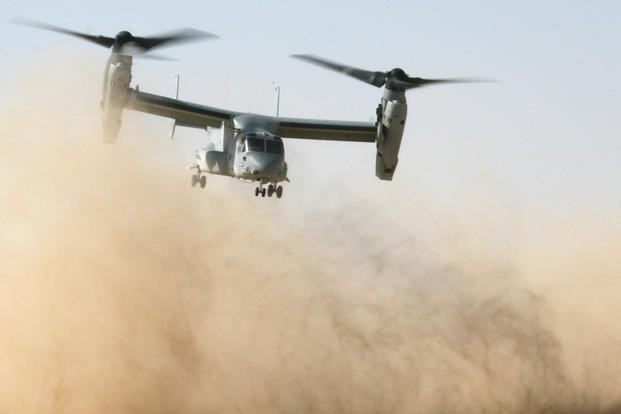Dirt and other debris keep taking a toll on Marine Corps and Air Force V-22 Osprey tiltrotor aircraft, and Pentagon inspectors fear there's not a good method available to protect the aircraft's engines and keep out rubble, according to a new watchdog report.
According to a redacted Defense Department Inspector General report released Tuesday, auditors found that a vacuum filtration system known as the Engine Air Particle Separators, or EAPS, which was designed to protect the V-22's engines, never met previous redesign requirements; the program, the IG said, could fall short again as engineers attempt a third redesign effort.
The V‑22 Joint Program Office, overseen by Naval Air Systems Command, "cannot be certain that the third EAPS redesign will correct long‑standing problems with the V‑22," according to the IG. Two previous EAPS redesign efforts occurred in 2010 and 2011.
Built-up material within the engines has been linked to at least one fatal aviation accident, posing a safety hazard.
Related: Billows of Dust, a Sudden 'Pop,' and an Osprey Falls to the Ground
In 2015, an MV-22B Osprey crashed in Hawaii, killing two and injuring more than 20.
A Marine Corps accident investigation report found that the pilots attempted to land the aircraft despite high levels of debris, which lead to low visibility.
"Repeated, sustained flight time in brownout conditions ... while attempting to land caused the left engine to stall, resulting in a loss of power that placed the aircraft in an unavoidable freefall to the ground," according to a news release about the investigation at the time.
The debris couldn't properly filter out, causing the stall, decreased lift and subsequent crash, officials said.
The service changed its hover standards -- to no more than 35 seconds max -- during Reduced Visibility Landing (RVL) profiles as a result of the accident.
Issues identified by the IG in the most recent EAPS report included the fact that the Navy did not meet V-22 engine maintenance standards set by Rolls-Royce, the manufacturer.
"When the [V-22 program manager] developed the specification for the original EAPS design, it did not require the EAPS to meet the Rolls‑Royce specification in all desert environments," the report states. The specification asserted a certain level of air cleanliness had to be maintained and limited the composition and concentration of soil that may be ingested by the V‑22 engine over an 11-hour period without causing engine degradation, it said.
DoDIG said it's skeptical of what future progress to meet better standards will look like.
Untested soil compositions also presented a problem. The IG said the V-22 JPO, also known as Program Manager, Air 275 (PMA‑275), isn't looking to test all soil types, focusing instead on those found in common operating environments, like the sandy regions of the Middle East.
"PMA‑275 intends to test the third EAPS redesign with soil that is not representative of all environments where the V‑22 operates, relying instead on military standard soil compositions and soil concentrations based on testing from a single desert environment," according to the report. "This occurred because the PMA‑275 is not taking advantage of the ability to tailor military standard soil samples."
Propelled by two Rolls Royce-Allison AE1107C turboshaft engines, the V-22 is not an aircraft that lands daintily. While its speed -- 200 miles per hour in some cases -- is its major selling point, the aircraft stirs up a huge wake of dust and debris when it lifts off or lands.
Engineers have already been working on the debris issue for nine years. If the Osprey continues to operate forward, it should be subjected to testing that assesses ways to remodel the EAPS, the report found.
Responding to the DoDIG report, the Navy said keeping operators safe is a priority. But it added that it cannot call for a major overhaul of the EAPS without completely altering the aircraft's configuration.
"The Deputy Program Manager described a multi‑layered approach the program office was taking to address safe operation of the V‑22 and stated that extensive research has led the PMA‑275 to conclude that it is not technically possible to develop, integrate, and field an EAPS that is fully capable of protecting the V‑22 engine from all possible soil types and concentrations for unlimited durations," according to the comments provided to auditors evaluating the program.
The service maintains the design will still "increase EAPS performance and provide greater protection for the V‑22 engine because it will decrease the amount of soil that will be ingested into the engine," the report said.
The Navy did not address DoDIG's recommendation to plan and test for additional types of soil, IG officials said.
-- Oriana Pawlyk can be reached at oriana.pawlyk@military.com. Follow her on Twitter at @Oriana0214.
Read more: Coast Guard to Name New Cutters After Reservists Who Died Responding to 9/11 Attacks













